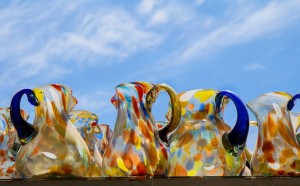The Art World Remembers the Incredible Contributions of Marvin Lipofsky
March 7, 2016
 Marvin Lipofsky, a founder of the studio glass movement, died suddenly this past January 15th. According to his studio assistant, his death was due to diabetes-related complications.
Marvin Lipofsky, a founder of the studio glass movement, died suddenly this past January 15th. According to his studio assistant, his death was due to diabetes-related complications.
At the Forefront of the Studio Glass Movement
The art world is taking time to remember the contributions Lipofsky made to blown glass art. A student in the 1960s at the University of Wisconsin, Lipofsky was able to partake in some of the first glassblowing glasses in the U.S. led by artist Harvey Littleton, while also receiving assistance from Dominick Labino, a chemist who was instrumental to the foundation of the studio glass movement.
From there, Lipofsky went on to establish his own glass programs at various California universities. Lipofsky took innovative approaches to his work, blending his understanding of sculpture and glass together and producing unique textures using everything from acid-washing to sandblasting, all to obtain his desired effects.
A Long and Illustrious Career
Lipofsky was also credited with starting the Great California Glass Symposium, an event he would help organize for 19 years afterward. Tina Oldknow, a retired curator for the Corning Museum of Glass, remarked to The New York Times that Lipofsky was instrumental in changing the industry’s perception of glass, making them realize glass art is more than an interior art decoration.
“Marvin was especially important in working with blown glass in a sculptural way,” noted Oldknow. The two major methods of glassblowing are mold-blowing and free-blowing; Lipofsky typically practiced free-blowing.
Lipofsky’s works are now part of art exhibitions around the world, including notable institutions such as the Metropolitan Museum of Art in New York City, and the Museum Bellrive in Zurich, among many others. For those interested in obtaining one of Lipofsky’s pieces, prices vary widely, but many of his works can be obtained for fairly reasonable amounts. About 71% of art collectors have now purchased works like those of Lipofsky’s on the Internet. Online art auctions list smaller pieces, such as “Soft Loop” and “Vessel,” with estimated art auction prices of $1,000 to $1,500. Larger, more ambitious pieces such as “Appalachian Group #2” or “Kentucky Series #9” are estimated to sell in the $5,000 to $10,000 range.
